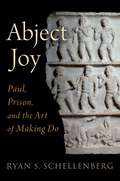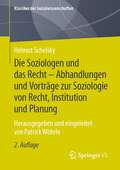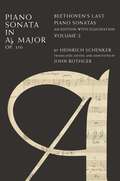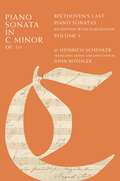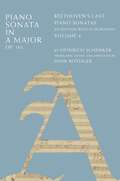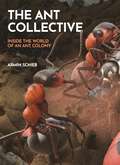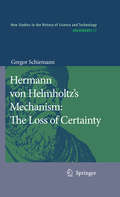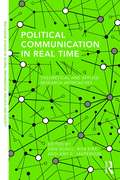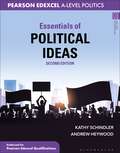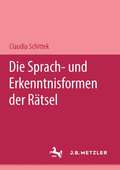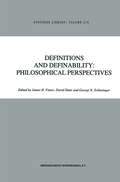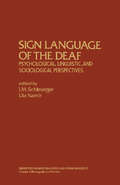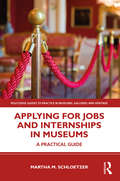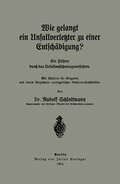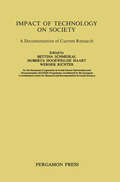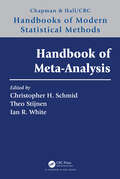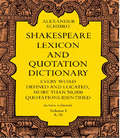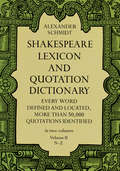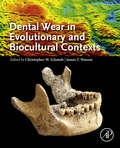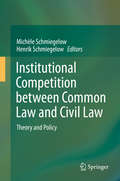- Table View
- List View
Abject Joy: Paul, Prison, and the Art of Making Do
by Ryan S. SchellenbergNo extant text gives so vivid a glimpse into the experience of an ancient prisoner as Paul's letter to the Philippians. As a letter from prison, however, it is not what one would expect. For although it is true that Paul, like some other ancient prisoners, speaks in Philippians of his yearning for death, what he expresses most conspicuously is contentment and even joy. Setting aside pious banalities that contrast true joy with happiness, and leaving behind too heroic depictions that take their cue from Acts, Abject Joy offers a reading of Paul's letter as both a means and an artifact of his provisional attempt to make do. By outlining the uses of punitive custody in the administration of Rome's eastern provinces and describing the prison's complex place in the social and moral imagination of the Greek and Roman world, Ryan Schellenberg provides a richly drawn account of Paul's nonelite social context, where bodies and their affects were shaped by acute contingency and habitual susceptibility to violent subjugation. Informed by recent work in the history of emotions, and with comparison to modern prison writing and ethnography provoking new questions and insights, Schellenberg describes Paul's letter as an affective technology, wielded at once on Paul himself and on his addressees, that works to strengthen his grasp on the very joy he names. Abject Joy: Paul, Prison, and the Art of Making Do by Ryan S. Schellenberg is a social history of prison in the Greek and Roman world that takes Paul's letter to the Philippians as its focal instance--or, to put it the other way around, a study of Paul's letter to the Philippians that takes the reality of prison as its starting point. Examining ancient perceptions of confinement, and placing this ancient evidence in dialogue with modern prison writing and ethnography, it describes Paul's urgent and unexpectedly joyful letter as a witness to the perplexing art of survival under constraint.
Abject Joy: Paul, Prison, and the Art of Making Do
by Ryan S. SchellenbergNo extant text gives so vivid a glimpse into the experience of an ancient prisoner as Paul's letter to the Philippians. As a letter from prison, however, it is not what one would expect. For although it is true that Paul, like some other ancient prisoners, speaks in Philippians of his yearning for death, what he expresses most conspicuously is contentment and even joy. Setting aside pious banalities that contrast true joy with happiness, and leaving behind too heroic depictions that take their cue from Acts, Abject Joy offers a reading of Paul's letter as both a means and an artifact of his provisional attempt to make do. By outlining the uses of punitive custody in the administration of Rome's eastern provinces and describing the prison's complex place in the social and moral imagination of the Greek and Roman world, Ryan Schellenberg provides a richly drawn account of Paul's nonelite social context, where bodies and their affects were shaped by acute contingency and habitual susceptibility to violent subjugation. Informed by recent work in the history of emotions, and with comparison to modern prison writing and ethnography provoking new questions and insights, Schellenberg describes Paul's letter as an affective technology, wielded at once on Paul himself and on his addressees, that works to strengthen his grasp on the very joy he names. Abject Joy: Paul, Prison, and the Art of Making Do by Ryan S. Schellenberg is a social history of prison in the Greek and Roman world that takes Paul's letter to the Philippians as its focal instance--or, to put it the other way around, a study of Paul's letter to the Philippians that takes the reality of prison as its starting point. Examining ancient perceptions of confinement, and placing this ancient evidence in dialogue with modern prison writing and ethnography, it describes Paul's urgent and unexpectedly joyful letter as a witness to the perplexing art of survival under constraint.
Die Soziologen und das Recht - Abhandlungen und Vorträge zur Soziologie von Recht, Institution und Planung: Herausgegeben und eingeleitet von Patrick Wöhrle (Klassiker der Sozialwissenschaften)
by Helmut SchelskyDas Buch enthält die wichtigsten Beiträge von Helmut Schelskys wissenschaftlichem Spätwerk, darunter dessen jüngst wieder verstärkt diskutierte Rechtssoziologie. Die neu verfasste Einleitung des Herausgebers erläutert den zeitgeschichtlichen und biographischen Entstehungskontext dieser Beiträge. Zudem bietet sie Anhaltspunkte für eine kritische Gesamtwürdigung insbesondere der rechtssoziologischen, aber auch der institutionentheoretischen und planungskritischen Schwerpunkte des Werks.
Piano Sonata in Ab, Op. 110: Beethoven's Last Piano Sonatas, An Edition with Elucidation, Volume 2
by Heinrich SchenkerHeinrich Schenker ranks among the most important figures in the development of western music theory in the twentieth century. His approach to the analysis of music permeates nearly every aspect of the field and continues to this day to be a topic of great interest among music theorists, historians, composers and performers. In his four volume work, Die letzen Sonaten von Beethoven: Kritische Ausgabe mit Einführung und Erläuterung (The Last Piano Sonatas by Beethoven: Critical edition with Introduction and Commentary) Schenker presented editions of Beethoven's Opp. 109, 110, 111 and 101 that were, at the time, unprecedented in their faithfulness to such authoritative sources as Beethoven's autograph manuscripts. He included a movement-by-movement and section-by-section discussion of form and content that grew increasingly penetrating from one volume to the next as the musical theory for which he is now known was developed, alongside inspired and detailed suggestions for the performance of each section of each work. In Beethoven's Last Piano Sonatas: An Edition, with Elucidation, noted Schenker scholar John Rothgeb presents the first English language edition and translation of these important works. Rothgeb builds upon Schenker's text, adding explanations of certain points in the commentary, references to corrections and other remarks entered by Schenker in his personal copies of the volumes, and graphic presentations of several passages (a practice that became standard in Schenker's own analytical work later in his career). Making these seminal works accessible to English speaking scholars and students for the first time, Beethoven's Last Piano Sonatas is an essential reference for music theorists, historians, performers, and composers alike.
Piano Sonata in C Minor, Op. 111: Beethoven's Last Piano Sonatas, An Edition with Elucidation, Volume 3
by Heinrich SchenkerHeinrich Schenker ranks among the most important figures in the development of western music theory in the twentieth century. His approach to the analysis of music permeates nearly every aspect of the field and continues to this day to be a topic of great interest among music theorists, historians, composers and performers. In his four volume work, Die letzen Sonaten von Beethoven: Kritische Ausgabe mit Einführung und Erläuterung (The Last Piano Sonatas by Beethoven: Critical edition with Introduction and Commentary) Schenker presented editions of Beethoven's Opp. 109, 110, 111 and 101 that were, at the time, unprecedented in their faithfulness to such authoritative sources as Beethoven's autograph manuscripts. He included a movement-by-movement and section-by-section discussion of form and content that grew increasingly penetrating from one volume to the next as the musical theory for which he is now known was developed, alongside inspired and detailed suggestions for the performance of each section of each work. In Beethoven's Last Piano Sonatas: An Edition, with Elucidation, noted Schenker scholar John Rothgeb presents the first English language edition and translation of these important works. Rothgeb builds upon Schenker's text, adding explanations of certain points in the commentary, references to corrections and other remarks entered by Schenker in his personal copies of the volumes, and graphic presentations of several passages (a practice that became standard in Schenker's own analytical work later in his career). Making these seminal works accessible to English speaking scholars and students for the first time, Beethoven's Last Piano Sonatas is an essential reference for music theorists, historians, performers, and composers alike.
Piano Sonata in E Major, Op. 109: Beethoven's Last Piano Sonatas, An Edition with Elucidation, Volume 1
by Heinrich SchenkerHeinrich Schenker ranks among the most important figures in the development of western music theory in the twentieth century. His approach to the analysis of music permeates nearly every aspect of the field and continues to this day to be a topic of great interest among music theorists, historians, composers and performers. In his four volume work, Die letzen Sonaten von Beethoven: Kritische Ausgabe mit Einführung und Erläuterung (The Last Piano Sonatas by Beethoven: Critical edition with Introduction and Commentary) Schenker presented editions of Beethoven's Opp. 109, 110, 111 and 101 that were, at the time, unprecedented in their faithfulness to such authoritative sources as Beethoven's autograph manuscripts. He included a movement-by-movement and section-by-section discussion of form and content that grew increasingly penetrating from one volume to the next as the musical theory for which he is now known was developed, alongside inspired and detailed suggestions for the performance of each section of each work. In Beethoven's Last Piano Sonatas: An Edition, with Elucidation, noted Schenker scholar John Rothgeb presents the first English language edition and translation of these important works. Rothgeb builds upon Schenker's text, adding explanations of certain points in the commentary, references to corrections and other remarks entered by Schenker in his personal copies of the volumes, and graphic presentations of several passages (a practice that became standard in Schenker's own analytical work later in his career). Making these seminal works accessible to English speaking scholars and students for the first time, Beethoven's Last Piano Sonatas is an essential reference for music theorists, historians, performers, and composers alike.
Piano Sonata in A Major, Op. 101: Beethoven's Last Piano Sonatas, An Edition with Elucidation, Volume 4
by Heinrich SchenkerHeinrich Schenker ranks among the most important figures in the development of western music theory in the twentieth century. His approach to the analysis of music permeates nearly every aspect of the field and continues to this day to be a topic of great interest among music theorists, historians, composers and performers. In his four volume work, Die letzen Sonaten von Beethoven: Kritische Ausgabe mit Einführung und Erläuterung (The Last Piano Sonatas by Beethoven: Critical edition with Introduction and Commentary) Schenker presented editions of Beethoven's Opp. 109, 110, 111 and 101 that were, at the time, unprecedented in their faithfulness to such authoritative sources as Beethoven's autograph manuscripts. He included a movement-by-movement and section-by-section discussion of form and content that grew increasingly penetrating from one volume to the next as the musical theory for which he is now known was developed, alongside inspired and detailed suggestions for the performance of each section of each work. In Beethoven's Last Piano Sonatas: An Edition, with Elucidation, noted Schenker scholar John Rothgeb presents the first English language edition and translation of these important works. Rothgeb builds upon Schenker's text, adding explanations of certain points in the commentary, references to corrections and other remarks entered by Schenker in his personal copies of the volumes, and graphic presentations of several passages (a practice that became standard in Schenker's own analytical work later in his career). Making these seminal works accessible to English speaking scholars and students for the first time, Beethoven's Last Piano Sonatas is an essential reference for music theorists, historians, performers, and composers alike.
The Ant Collective: Inside the World of an Ant Colony
by Armin SchiebAnts come alive on this fabulously illustrated journey into the heart of a bustling colonyAnts share a vibrant and complex communal life and remarkable abilities to communicate with each other. The Ant Collective presents the world of ants as you have never seen it before, using hyperrealistic, computer-generated imagery that shows 3D-like views of activities inside and outside a thriving nest of red wood ants. With chapters on topics ranging from the establishment and construction of the nest to the birth of an ant trail and the relocation of a colony, this one-of-a-kind book brilliantly integrates informative descriptions with the illustrations, drawing on the latest science to reveal the innermost workings of the colony and enabling you to explore the ant collective as if you are there.Features a wealth of naturalistic 3D-like illustrations and schematic infographicsDepicts the anatomy of ants, the architecture of their nests, their interactions with the environment and other animals, and their collective social behaviorFollows the annual life cycle of the colonyProvides an incredible up-close look at ant reproduction, defense, foraging, nesting, division of labor, and morePacked with information about the biology, ecology, and communication skills of these marvelous insects
Hermann von Helmholtz’s Mechanism: A Study on the Transition from Classical to Modern Philosophy of Nature (Archimedes #17)
by Gregor SchiemannFocusing on Hermann von Helmholtz, this study addresses one of the nineteenth century’s most important German natural scientists. Among his most well-known contributions to science are the invention of the ophthalmoscope and grou- breaking work towards formulating the law of the conservation of energy. The volume of his work, reaching from medicine to physiology to physics and epis- mology, his impact on the development of the sciences far beyond German borders, and the contribution he made to the organization and popularization of research, all established Helmholtz’s prominence both in the academic world and in public cultural life. Helmholtz was also one of the last representatives of a conception of nature that strove to reduce all phenomena to matter in motion. In reaction to the increasingly insurmountable difficulties that program had in fulfilling its own standards for s- entific explanation, he developed elements of a modern understanding of science that have remained of fundamental importance to this day.
Political Communication in Real Time: Theoretical and Applied Research Approaches (Routledge Studies in Global Information, Politics and Society)
by Dan Schill Rita Kirk Amy E. JaspersonMuch has been made of the speed and constancy of modern politics. Whether watching cable news, retweeting political posts, or receiving news alerts on our phones, political communication now happens continuously and in real time. Traditional research methods often do not capture this dynamic environment. Early studies that guided the study of political communication took place at a time when transistors and FM radio, television, and widely distributed films technologically changed the way people gained information and developed knowledge of the world around them. Now, the environment has transformed again through digital innovations. This book provides one of the first systematic assessment of real-time methods used to study the new digital media environment. It features twelve chapters—authored by leading researchers in the field—using continuous or real time response methods to study political communication in various forms. Moreover, the authors explain how viewer attitudes can be measured over time, message effects can be pin-pointed down to the second of impact, behaviors can be tracked and analyzed unobtrusively, and respondents can naturally respond on their smartphone, tablet, or even console gaming system. Leading practitioners in the field working for CNN, Microsoft, and Twitter show how the approach is being innovatively used in the field. Political Communication in Real Time is a welcome addition to the growing field of interest in "big data" and continuous response research. This volume will appeal to scholars and practitioners in political science and communication studies wishing to gain new insights into the strengths and limitations of this approach. Political communication is a continuous process, so theories, applications, and cognitive models of such communication require continuous measures and methods.
Political Communication in Real Time: Theoretical and Applied Research Approaches (Routledge Studies in Global Information, Politics and Society)
by Dan Schill Rita Kirk Amy E. JaspersonMuch has been made of the speed and constancy of modern politics. Whether watching cable news, retweeting political posts, or receiving news alerts on our phones, political communication now happens continuously and in real time. Traditional research methods often do not capture this dynamic environment. Early studies that guided the study of political communication took place at a time when transistors and FM radio, television, and widely distributed films technologically changed the way people gained information and developed knowledge of the world around them. Now, the environment has transformed again through digital innovations. This book provides one of the first systematic assessment of real-time methods used to study the new digital media environment. It features twelve chapters—authored by leading researchers in the field—using continuous or real time response methods to study political communication in various forms. Moreover, the authors explain how viewer attitudes can be measured over time, message effects can be pin-pointed down to the second of impact, behaviors can be tracked and analyzed unobtrusively, and respondents can naturally respond on their smartphone, tablet, or even console gaming system. Leading practitioners in the field working for CNN, Microsoft, and Twitter show how the approach is being innovatively used in the field. Political Communication in Real Time is a welcome addition to the growing field of interest in "big data" and continuous response research. This volume will appeal to scholars and practitioners in political science and communication studies wishing to gain new insights into the strengths and limitations of this approach. Political communication is a continuous process, so theories, applications, and cognitive models of such communication require continuous measures and methods.
Essentials of Political Ideas: For Pearson Edexcel Politics A-Level
by Kathy Schindler Andrew HeywoodRefreshed and completely restructured to align with the new Edexcel Politics A-Level specification, this is the new edition of Andrew Heywood's highly respected introduction to political ideas, ideologies and thinkers for A-Level students. Essentials of Political Ideas is the only Edexcel-specific text on ideas on the market. Suitable for flexible use across all ideas components of the A-Level course, it offers full coverage of both the core political ideas (conservatism, liberalism and socialism) and the non-core ideas (anarchism, ecologism, feminism, multiculturalism and nationalism). Drawing on her extensive teaching, examining and workshop experience, Kathy Schindler has adapted the text to make it even more student-friendly and focused on exam success. Practical and informative pedagogy, from Key Thinker boxes to Similarities and Differences summaries, will enable students to understand and analyse key political concepts and thinkers and construct persuasive arguments using the correct terminology. This new edition offers:· A dedicated Exam Skills chapter, giving advice for exam success alongside annotated example answers· An extensive companion website with further sample answers, teaching tips, revision planning resources, links for further study and more· Coverage of thinkers not included on the specification, helping students to place their understanding in a broader context
Essentials of Political Ideas: For Pearson Edexcel Politics A-Level
by Kathy Schindler Andrew HeywoodRefreshed and completely restructured to align with the new Edexcel Politics A-Level specification, this is the new edition of Andrew Heywood's highly respected introduction to political ideas, ideologies and thinkers for A-Level students. Essentials of Political Ideas is the only Edexcel-specific text on ideas on the market. Suitable for flexible use across all ideas components of the A-Level course, it offers full coverage of both the core political ideas (conservatism, liberalism and socialism) and the non-core ideas (anarchism, ecologism, feminism, multiculturalism and nationalism). Drawing on her extensive teaching, examining and workshop experience, Kathy Schindler has adapted the text to make it even more student-friendly and focused on exam success. Practical and informative pedagogy, from Key Thinker boxes to Similarities and Differences summaries, will enable students to understand and analyse key political concepts and thinkers and construct persuasive arguments using the correct terminology. This new edition offers:· A dedicated Exam Skills chapter, giving advice for exam success alongside annotated example answers· An extensive companion website with further sample answers, teaching tips, revision planning resources, links for further study and more· Coverage of thinkers not included on the specification, helping students to place their understanding in a broader context
Definitions and Definability: Philosophical Perspectives (Synthese Library #216)
by George N. Schlesinger DavidShatz James H. FetzerSign Language of the Deaf: Psychological, Linguistic, and Sociological Perspectives
by I. M. Schlesinger Lila NamirSign Language of the Deaf: Psychological, Linguistic, and Sociological Perspectives provides information pertinent to the psychological, educational, social, and linguistic aspects of sign language. This book presents the development in the study of sign language.Organized into four parts encompassing 10 chapters, this book begins with an overview of the fascinating account of sign language acquisition by small children. This text then explores the grammar of sign language and discusses the linguistic status of natural and contrived sign languages. Other chapters consider the many peculiarities of the lexicon and grammar of sign language, and its differences in such respects from oral language. This book discusses as well sign language from the angle of psycholinguistics. The final chapter deals with the educational implications of the use of sign language.This book is a valuable resource for linguists and psycholinguists. Readers who are interested in sign language will also find this book useful.
Applying for Jobs and Internships in Museums: A Practical Guide (Routledge Guides to Practice in Museums, Galleries and Heritage)
by Martha M. SchloetzerApplying for Jobs and Internships in Museums offers a straightforward approach to applying for positions within a museum. Martha M. Schloetzer provides practical advice about the application and interview process that will prepare emerging museum professionals as they approach the profession. From reviewing job and internship postings to developing a solid resume and writing distinctive cover letters, this guide provides practical, sound advice for museum job seekers. Schloetzer integrates the stories of successful and unsuccessful interns and job applicants throughout the book’s narrative, and recognizing the additional challenges faced by non-US nationals, the book also offers information specifically for international students seeking work experience in US museums. The insider information included in Applying for Jobs and Internships in Museums makes it a key resource for both a US and international audience interested in gaining museum experience in the US. It will be of particular interest to college-level and graduate school students, as well as recent graduates. The guide can also serve as a reference in the classroom, helping professors and instructors prepare students for the job search ahead.
Applying for Jobs and Internships in Museums: A Practical Guide (Routledge Guides to Practice in Museums, Galleries and Heritage)
by Martha M. SchloetzerApplying for Jobs and Internships in Museums offers a straightforward approach to applying for positions within a museum. Martha M. Schloetzer provides practical advice about the application and interview process that will prepare emerging museum professionals as they approach the profession. From reviewing job and internship postings to developing a solid resume and writing distinctive cover letters, this guide provides practical, sound advice for museum job seekers. Schloetzer integrates the stories of successful and unsuccessful interns and job applicants throughout the book’s narrative, and recognizing the additional challenges faced by non-US nationals, the book also offers information specifically for international students seeking work experience in US museums. The insider information included in Applying for Jobs and Internships in Museums makes it a key resource for both a US and international audience interested in gaining museum experience in the US. It will be of particular interest to college-level and graduate school students, as well as recent graduates. The guide can also serve as a reference in the classroom, helping professors and instructors prepare students for the job search ahead.
Wie gelangt ein Unfallverletzter zu einer Entschädigung?: Ein Füher durch das Unfallversicherungsverfahren
by Rudolf SchlottmannDieser Buchtitel ist Teil des Digitalisierungsprojekts Springer Book Archives mit Publikationen, die seit den Anfängen des Verlags von 1842 erschienen sind. Der Verlag stellt mit diesem Archiv Quellen für die historische wie auch die disziplingeschichtliche Forschung zur Verfügung, die jeweils im historischen Kontext betrachtet werden müssen. Dieser Titel erschien in der Zeit vor 1945 und wird daher in seiner zeittypischen politisch-ideologischen Ausrichtung vom Verlag nicht beworben.
Impact of Technology on Society: A Documentation of Current Research (Vienna Centre)
by B. Schmeikal H. Hogeweg-De Haart W. RichterThis book consists of an inventory of research projects on the impact of technology on society. Research in this field is of growing importance as the flood of technological innovation continues. This survey indicates considerable activity in the areas of microelectronics and information technology, but with a need for more consistency and balance. By building together detailed information on current research, the volume not only increases awareness of what has been done, but also indicates areas needing further research.
Handbook of Meta-Analysis (Chapman & Hall/CRC Handbooks of Modern Statistical Methods)
by Christopher H. Schmid Theo Stijnen Ian WhiteMeta-analysis is the application of statistics to combine results from multiple studies and draw appropriate inferences. Its use and importance have exploded over the last 25 years as the need for a robust evidence base has become clear in many scientific areas, including medicine and health, social sciences, education, psychology, ecology, and economics. Recent years have seen an explosion of methods for handling complexities in meta-analysis, including explained and unexplained heterogeneity between studies, publication bias, and sparse data. At the same time, meta-analysis has been extended beyond simple two-group comparisons of continuous and binary outcomes to comparing and ranking the outcomes from multiple groups, to complex observational studies, to assessing heterogeneity of effects, and to survival and multivariate outcomes. Many of these methods are statistically complex and are tailored to specific types of data. Key features Rigorous coverage of the full range of current statistical methodology used in meta-analysis Comprehensive, coherent, and unified overview of the statistical foundations behind meta-analysis Detailed description of the primary methods for both univariate and multivariate data Computer code to reproduce examples in chapters Thorough review of the literature with thousands of references Applications to specific types of biomedical and social science data Supplementary website with code, data, sample chapters, and errata This book is for a broad audience of graduate students, researchers, and practitioners interested in the theory and application of statistical methods for meta-analysis. It is written at the level of graduate courses in statistics, but will be of interest to and readable for quantitative scientists from a range of disciplines. The book can be used as a graduate level textbook, as a general reference for methods, or as an introduction to specialized topics using state-of-the art methods.
Shakespeare Lexicon and Quotation Dictionary: A Complete Dictionary Of All The English Words, Phrases, And Constructions In The Works Of The Poet (Third Edition)
by Alexander SchmidtIn more than 300 years of Shakespearean scholarship, only one book, the famous Shakespeare Lexicon and Quotation Dictionary, has investigated the meaning of every word that Shakespeare wrote. The lifetime work of Professor Alexander Schmidt of Königsberg, this book has long been the indispensable companion for every person seriously interested in Shakespeare, Renaissance poetry and prose of any sort, or English literature. It is really two important books in one. <p><p> Schmidt’s set contains every single word that Shakespeare used, not simply words that have changed their meaning since the seventeenth century, but every word in all the accepted plays and the poems. Covering both quartos and folios, it carefully distinguishes between shades of meaning for each word and provides exact definitions, plus governing phrases and locations, down to the numbered line of the Cambridge edition of Shakespeare. There is no other word dictionary comparable to this work. <p> Even more useful to the general reader, however, is the incredible wealth of exact quotations. Arranged under the words of the quotation itself (hence no need to consult confusing subject classifications) are more than 50,000 exact quotations. Each is precisely located, so that you can easily refer back to the plays or poems themselves, if you wish context.Other features helpful to the scholar are appendixes on basic grammatical observations, a glossary of provincialisms, a list of words and sentences taken from foreign languages, a list of words that form the latter part of word-combinations. This third edition features a supplement with new findings.
Shakespeare Lexicon and Quotation Dictionary (Third Edition)
by Alexander SchmidtIn more than 300 years of Shakespearean scholarship, only one book, the famous Shakespeare Lexicon and Quotation Dictionary, has investigated the meaning of every word that Shakespeare wrote. The lifetime work of Professor Alexander Schmidt of Königsberg, this book has long been the indispensable companion for every person seriously interested in Shakespeare, Renaissance poetry and prose of any sort, or English literature. It is really two important books in one. <p><p> Schmidt’s set contains every single word that Shakespeare used, not simply words that have changed their meaning since the seventeenth century, but every word in all the accepted plays and the poems. Covering both quartos and folios, it carefully distinguishes between shades of meaning for each word and provides exact definitions, plus governing phrases and locations, down to the numbered line of the Cambridge edition of Shakespeare. There is no other word dictionary comparable to this work. <p> Even more useful to the general reader, however, is the incredible wealth of exact quotations. Arranged under the words of the quotation itself (hence no need to consult confusing subject classifications) are more than 50,000 exact quotations. Each is precisely located, so that you can easily refer back to the plays or poems themselves, if you wish context.Other features helpful to the scholar are appendixes on basic grammatical observations, a glossary of provincialisms, a list of words and sentences taken from foreign languages, a list of words that form the latter part of word-combinations. This third edition features a supplement with new findings.
Dental Wear in Evolutionary and Biocultural Contexts
by Christopher W. Schmidt James T. WatsonDental Wear in Evolutionary and Biocultural Contexts provides a single source for disseminating the current state-of-the-art research regarding dental wear across a variety of hominoid species under a number of temporal and spatial contexts. The volume begins with a brief introductory chapter addressing the general history, understandings and approaches to the study of dental wear. Remaining chapters cover dental macrowear and dental microwear. Students and professionals in anthropology, specifically paleoanthropologists, bioarcheologists, archaeologists, and primatologists will find this book to be a valuable resource. In addition, it is a helpful guide for dentists and other dental professionals interested in dental function.Covers a wide range of topics, including method and theory, macrowear and microwear in primates, and fossil homininsHighlights several recent technological innovations, including occlusal fingerprinting, considerations of enamel mechanical properties, and microwear textureIncludes case studies from archaeological populations
Institutional Competition between Common Law and Civil Law: Theory and Policy
by Michèle Schmiegelow Henrik SchmiegelowThis book addresses two countervailing challenges to theory and policy in law and economics. The first is the rise of legal origins theory, which denies the comparative law view of convergence between common law and civil law by the assertion of an economic superiority of common law. The second is the series of economic crises in the very financial markets on which that assertion was based. Both trends unsettled certainties about the rule of law and institutional economics.Meeting legal origins theory in its main areas of political science, sociology and economics, the book extends the interdisciplinary reach to neglected aspects of comparative law, legal history, dynamic econometric analysis and "quasi-natural experiments" with counterfactual evidence of different institutional regimes in divided countries. These combined methodological tools make tests of the economic impact of different legal origins much more reliable. This is shown for developed and newly industrialized countries as well as developing, transforming and emerging countries with or without financial center advantage, affected or not by financial crises. The Asian financial crises and the American subprime crisis have been, or could have been resolved using the resources of common law or civil law. These cases and data on access to justice in Africa, Asia and Latin America reveal the problem of substantive law remaining "law on the books" without efficient procedural rules and judicial structures. The single most striking common law-civil law divide is that lawyer-dominated common law procedure is slower and costlier than judge-managed civil law procedure.Countries as diverse as the Netherlands, Japan, and China show functional interaction between culture and law in legal reforms. Such interaction can reduce the occurrence of legal disputes as well as facilitate their resolution. It can use economic crises as catalysts for legal reforms or rely on regional integration, and it should replace the discredited method of legal "transplants" by sustained dialogue between legal advisors and all actors involved in legal reforms.
